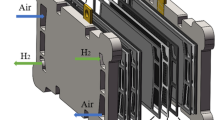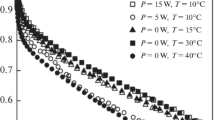Abstract
Forced-convection open-cathode proton exchange membrane fuel cells have attracted much attention due to simple structure. The fan, as an important component of the stack, significantly influences the mass density and performance of the stack. Therefore, it is crucial to select the appropriate fan. In this study, the performance of stacks with different fans is compared and the optimal duty ratio and temperature of stacks under different load currents are determined. The experimental results show that excessive air volume reduces the performance of the stack, and the parasitic power should be taken into consideration. Additionally, the weight of the fan is is a significant factor that needs to be considered. Furthermore, the experimental results show that under the condition of sufficient air supply, the appropriate temperature rise is conducive to the improvement of stack performance. In order to reduce the weight of the stack, it is necessary to choose a reasonable fan.
You have full access to this open access chapter, Download conference paper PDF
Similar content being viewed by others
Keywords
1 Instruction
Proton exchange membrane fuel cell (PEMFC) has received a lot of attention in recent decades due to low temperature start-up, high efficiency and zero emissions [1]. PEMFC is a device that directly converts chemical energy to electric energy. Among several proton exchange membrane fuel cell types, forced-convection open-cathode PEMFC is more suitable for portable and unmanned aerial vehicles (UAV) energy because of removing the complex oxidant supply system [2]. The forced-convection PEMFC utilizes an axial fan as the air supply device. In addition to providing oxidant, the fan also serves to dissipate heat and remove water. Using only fans can make the stack more compact and reduce the mass of the stack and improve portability. However, because the cathode absorbs air directly from the atmosphere, the stack performance is sensitive to changes in cathode parameters, especially fans.
Water, thermal and gas management is critical for fuel cell. Fan air supply, heat dissipation and water remove coupling, water, thermal and gas management is more complex for forced-convection open-cathode PEMFC. Several studies have explored the effect of air flow-rate selection [3,4,5,6,7]. These studies focused on performance performance and stack temperature variation. The research shown that the appropriate air flow rate can ensure the stack working at the optimum temperature without Membrane dehydration under adequate air supply. Other studies have explored the effects of parasitic power [8], fan placement parameters [9, 10].
In this work, we discussed the variation in the performance of three axial flow fans with different parameters installed on the same stack, and analyzed the possible causes of the variation in performance, and considered the weight of the fan as a factor in the selection of the fan. Finally, the relationship between fan duty ratio and fan temperature and performance is studied.
2 Experimental
2.1 Experimental Setup
For this work, we used a laboratory designed stack. The forced-convection OC-PEMFC consists of 15 cells. The 3 mm graphite was manufactured into bipolar plates using CNC (Computer Numerical Control) technology. The active area is 3.5 mm × 1.5 mm. Commercial MEA (Membrane Electrode Assembly) was used. Figure 1 shows the stack used in the experiment.
A hydrogen generator is used as the hydrogen source. The reducing valve is used to regulate the input pressure of the stack. An electronic load is used in order to obtain a polarization curve. A PWM controller is used to regulate air flow rate. Figure 2 shows the experimental schematic diagram.
2.2 Test Conditions
The forced-convection OC-PEMFC performance was tested with different axial flow fans. The fan parameters were shown in Table 1. Rated voltage of fan was 12 V. Temperature changes in the stack were measured using thermocouples inserted into the stack. The duty ratio varies from 100 to 30% to study the effect of the fan on the stack temperature and net power.
3 Results and Discussion
3.1 Effect of Different Fan on Stack Performance
In this work, we test the performance of the stack under different axial flow fans. The three axial fans have different parameters. Figure 3 shows the performance of stack. It is clearly observed that for the experimental stack, the performance of the stack does not change much under different fan conditions. From Table 1 we can see that the 4028 fan provides more air, but from Fig. 3 we can see that the excessive air flow slightly reduces the stack performance due to the excess water taken away.
In open cathode stacks, the fan usually consumes the power generated by the stack. The net power density curve of the stack is shown in Fig. 4. After removing the parasitic power of the fan, 4028 fan exhibited poor performance due to excessive parasitic power. It seems that the 4015 fan exhibits superior performance over the 4010 fan due to the smaller parasitic power. The performance gap between 4015 fan and 4010 fan decreases with the increase of load current. In addition, we can see from Table 1 that 4028 fan has the highest weight. This was followed by 4015 and 4010. The weight of the stack excluding the fan is 205 g. Comparatively speaking, 4015 and 4010 fans are better choices.
3.2 Effect of Fan Duty Ratio on Stack Temperature and Performance
Next, the influence of air flow rate variation on stack performance and temperature is analyzed. Adjust the air flow rate by adjusting the PWM duty ratio. The stack with 4015 fan was used for testing. Figure 5 shows the change of stack temperature with fan duty ratio at 2.5, 3 and 3.5 A. It can be seen from Fig. 3 that with the decrease of duty ratio, the temperature of the stack increases gradually, which can be attributed to the decrease of the heat dissipation capacity of the fan. Figure 6 shows the change curve of the net power density of the stack with the change of duty ratio under the load current conditions of 2, 2.5 and 3 A. It can be seen from Fig. 4 that with the reduction of duty ratio, the performance of the stack first improves and then begins to decline.
Combined with the temperature variation shown in Fig. 5, it can be considered that the performance variation is related to the temperature variation of the stack. Under sufficient oxidant conditions, with the increase of the stack temperature, the chemical reaction rate is accelerated, and the stack performance is improved. However, with the increase of the stack temperature, the high temperature will cause the membrane dehydration, the increase of ohmic resistance, and the stack performance is decreased. In addition, it can be seen that under the load current conditions of 2 A, 2.5 A and 3 A, the optimal operating temperature of the stack is about 44.3 ℃, 49.8 ℃ and 49.5 ℃, and the optimal duty ratio is about 30%, 40% and 50%, respectively.
4 Conclusion
In this study, stacks with different fans were tested. The polarization curve and temperature of the stack were measured to investigate the effects of different fans and duty ratio. The experiment proves that the reasonable choice of fan is necessary. A suitable fan allows the stack to operate near the optimum operating point and effectively reduces the overall system weight.
References
Wang, Y., Ruiz Diaz, D.F., Chen, K.S., Wang, Z., Adroher, X.C.: Materials, technological status, and fundamentals of PEM fuel cells—a review. Mater. Today 32, 178–203 (2020)
Kurnia, J.C., Chaedir, B.A., Sasmito, A.P., Shamim, T.: Progress on open cathode proton exchange membrane fuel cell: performance, designs, challenges and future directions. Appl. Energ. 283 (2021)
Wang, Z., Tongsh, C., Wang, B., Liu, Z., Du, Q., Jiao, K.: Operation characteristics of open-cathode proton exchange membrane fuel cell with different cathode flow fields. Sustain. Energ. Technol. Assess. 49 (2022)
Zeng, T., Zhang, C., Huang, Z., Li, M., Chan, S.H., Li, Q., et al.: Experimental investigation on the mechanism of variable fan speed control in Open cathode PEM fuel cell. Int. J. Hydrogen Energ. 44, 24017–27 (2019). Author, F.: Contribution title. In: 9th International Proceedings on Proceedings, pp. 1–2. Publisher, Location (2010)
Song, Y., Zhang, C., Deshpande, A., Tan, K., Han, M.: Fixed air flow-rate selection by considering the self-regulating function of low power air-cooled PEMFC stack. Int. J. Heat Mass Transf. 158 (2020)
Huang, Z.-M., Su, A., Liu, Y.-C.: Development and testing of a hybrid system with a sub-kW open-cathode type PEM (proton exchange membrane) fuel cell stack. Energy 72, 547–553 (2014)
Sasmito, A.P., Kurnia, J.C., Shamim, T., Mujumdar, A.S.: Optimization of an open-cathode polymer electrolyte fuel cells stack utilizing Taguchi method. Appl. Energ. 185, 1225–1232 (2017)
Meyer, Q., Himeur, A., Ashton, S., Curnick, O., Clague, R., Reisch, T., et al.: System-level electro-thermal optimisation of air-cooled open-cathode polymer electrolyte fuel cells: air blower parasitic load and schemes for dynamic operation. Int. J. Hydrogen Energ. 40, 16760–16766 (2015)
Ling, C.Y., Cao, H., Chen, Y., Han, M., Birgersson, E.: Compact open cathode feed system for PEMFCs. Appl. Energ. 164, 670–675 (2016)
Zhao, C., Xing, S., Liu, W., Wang, H.: Air and H2 feed systems optimization for open-cathode proton exchange membrane fuel cells. Int. J. Hydrogen Energ. 46, 11940–11951 (2021)
Author information
Authors and Affiliations
Corresponding author
Editor information
Editors and Affiliations
Rights and permissions
Open Access This chapter is licensed under the terms of the Creative Commons Attribution 4.0 International License (http://creativecommons.org/licenses/by/4.0/), which permits use, sharing, adaptation, distribution and reproduction in any medium or format, as long as you give appropriate credit to the original author(s) and the source, provide a link to the Creative Commons license and indicate if changes were made.
The images or other third party material in this chapter are included in the chapter's Creative Commons license, unless indicated otherwise in a credit line to the material. If material is not included in the chapter's Creative Commons license and your intended use is not permitted by statutory regulation or exceeds the permitted use, you will need to obtain permission directly from the copyright holder.
Copyright information
© 2024 The Author(s)
About this paper
Cite this paper
Zhou, J., Fang, Z., Deng, H. (2024). Effect of Fan Parameters on Forced-Convection Open-Cathode Proton Exchange Membrane Fuel Cells. In: Sun, H., Pei, W., Dong, Y., Yu, H., You, S. (eds) Proceedings of the 10th Hydrogen Technology Convention, Volume 1. WHTC 2023. Springer Proceedings in Physics, vol 393. Springer, Singapore. https://doi.org/10.1007/978-981-99-8631-6_42
Download citation
DOI: https://doi.org/10.1007/978-981-99-8631-6_42
Published:
Publisher Name: Springer, Singapore
Print ISBN: 978-981-99-8630-9
Online ISBN: 978-981-99-8631-6
eBook Packages: Physics and AstronomyPhysics and Astronomy (R0)










